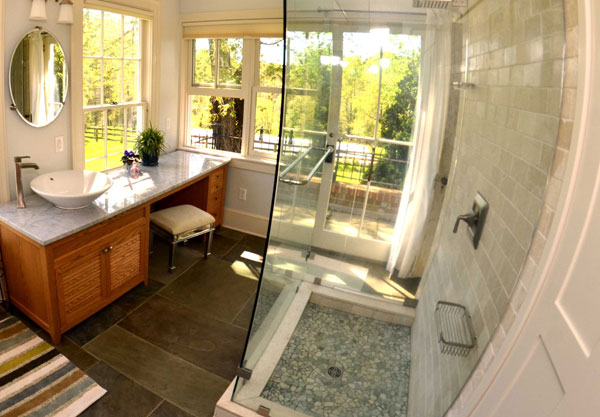 Tile Choices for Construction and Renovation
Tile Choices for Construction and Renovation
Ceramic and stone tiles have become a very popular construction material when renovating an existing home or building a new house. We will discuss the types of ceramic and stone tiling options and the benefits and usage of each type. When choosing tile materials for flooring, counter tops, back splashes and shower or bath, it is good to know which tile materials work best for that placement.
Tiles may be broadly divided into two types, ceramic and stone. Both are then sub-divided into other types.
Ceramic Tile
Ceramic tile is manufactured from quarried, prepared, and molded clay. The two types of ceramic tiles are:
Porcelain
Porcelain ceramic tile while composed of clay and minerals, also contains 50% of feldspar crystals – a kind of white sand. These crystals melt during the kiln-drying process to form a glass-like material that bonds all the other ingredients together. Even with minor modifications to the ingredients or tile making process, a huge variety of porcelain tiles can be achieved. More durable, stain resistant, and less water absorbent than non-porcelain tiles, porcelain tiles also demonstrate a thorough-bodied color. Porcelain tile is well-suited for construction of exterior walls and floors.
Non-Porcelain
Made from either red, white, or brown clay, non-porcelain tiles are one of the most economical types.
Both types come in unglazed and glazed varieties. The glazed tile may come in semi-high gloss or matte look. Glazed tiles will be increasingly resistant to stains, scratches, traction, and water absorption, making them ideal for bathroom floors and walls.
Natural Stone Tile
Many people like the natural earthy look of stone tiles. Depending upon the location and time of the stone being quarried, slabbed, and finished, stone tiles come in many varieties. For foyers, and hallways – high-traffic areas – stone tiles with a matte or satin finish last longer, whereas highly polished tile begins to show wear patterns.
Granite
Granite is an igneous, dense, and hard rock with a distinctive speckled appearance and unique veining that comes in multitudes of colors. Almost impervious and scratch resistant, this tile makes an excellent choice for kitchen floors and countertops, other high-traffic areas, such as curbs and paving stones, solid, colorful, and durable workstations, such as sinks, and backsplash.
Marble
A metamorphic rock available in many colors and featuring rich veining, marble is more porous and not suited for kitchen flooring. It is, however, a perfect choice for interior walls and floors in areas with moderate traffic.
Limestone
A sedimentary rock that comes in both light and dark shades, limestone’s earthy appearance can be polished smooth or textured. Use limestone for structural and entry walls, the area around a fireplace, vanities, and shower walls.
Travertine
A limestone type that has a crystallized appearance and an earthy tone, the surface has natural pitting. Like limestone, travertine is perfect for entry walls, fireplace surrounds, shower walls, vanities, tub decks and mosaics.
Slate
Slate is a type of metamorphic rock that is extremely dense and very durable. Slate is available in darker earthy tones. The surface of slate is naturally textured unless a smooth, honed finish is achieved. Slate is an excellent choice for kitchen – countertops and wet bars – roofing and high-traffic area flooring, such as walkways.
Other
Other stone types include onyx and quartzite.
The Benefits of Tile
1. Environmentally friendly. Little to no volatile organic compounds are found in ceramic tile and stone, as compared to other types. They contribute towards building a healthy environment.
2. Durability. High durability and sustainability makes ceramic and stone an ideal choice. Floorings, such as carpets need replacement after every 7-10 years, making them less economical.
3. Mildew resistant. Good fighters against mildew and mold, ceramic and stone are constructed from materials that are not food sources for mold and mildew. Less mold and mildew is healthier for your home.
4. Moisture resistant. Inherently water resistant, ceramic, and stone do not degrade when exposed to moisture.
The type of tile you choose will depend on your usage – amount of traffic, area covered, type of area being covered etc – and budget. Choose wisely, although keep in mind that stone and ceramic tiles are more durable, healthy, and sustainable than other building material choices out there. Weston Construction can help you assess the best tiling materials to use for your new home construction or renovation.